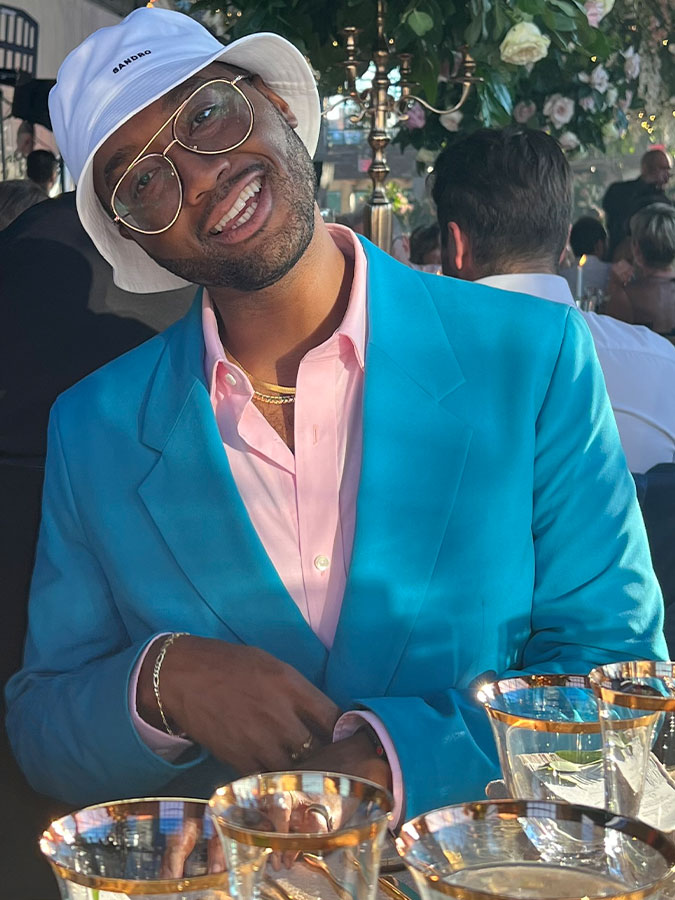I’ve always been fascinated by fashion. I find it to be the most accessible form of art: a way to express yourself to everyone who sees you, without saying a word. Even as a kid, I adored the absurd, the ostentatious, but also the subtle. Growing up in Brooklyn, I was exposed to it all, some of it admittedly not that great (See: Juicy Couture). Celebrities were my favorite fashion icons. It seemed like they got a free pass to express themselves. Lil’ Kim could wear a jumpsuit and pasties, because she wasn’t afraid to embrace her sexuality. Prince could wear all the feathers, fringe and bright colors he wanted; he was never too timid to proclaim his flamboyance. I suppose I envied them. I was a Black, gay kid who needed to fit in.


After I came out of the closet in high school, I thought it would be easier. I mean, everyone knew who I was, right? Quickly, I realized that it wasn’t just about being gay; it was about being perceived to be overly feminine. Even my grandmother would say, “It’s okay to be gay but do you really have to talk like that or walk like that?” Honestly, I couldn’t blame her; she loved me and only wanted the best for me. After all, it’s not always the greatest idea for a Black man to stick out in society, gay or not. So I toed the line. I’d wear a pop of color here or there, but never too much.
After college, I moved to West Hollywood. It seemed that everyone was expressing themselves freely. Don’t get me wrong, I still wrestled with the idea of truly expressing myself, but, eventually, I found my tribe. It wasn’t at all outlandish for us to rock wigs to the club. For the first time in my life, I felt like I could show the world who I was.
I think that’s why I’ve always been drawn to wine flaws. When I think about some of the first wines I fell in love with—mostly Italian—I think about their bold nature. Wines like Andrea Occhipinti’s aleatico, Alea Viva, had rustic smells of manure, yet were intoxicatingly floral. Others, like Radikon’s Sivi pinot grigio, were packed with tropical fruit underlined by a salty volatile acidity. They were unapologetically themselves. I didn’t realize they could be considered technically flawed. I loved them because they were so different from anything else I’d tasted.
I was a Black, gay kid who needed to fit in. I didn’t think I could express myself the way I really wanted to. I could never stand out that much.
Yet, it seemed like the more immersed I became in the world of wine, the more I felt like I had to camouflage myself again. The standards of self-expression felt different for me. One of my more embarrassing moments was when I first started selling wine on the floor of a casual Italian restaurant. I was wearing a button-up with a sweater, black jeans, dark sneakers, and a beanie (just to add a little color). Surely, I was dressed well enough, considering the general manager was sporting a t-shirt, light-blue jeans and Birkenstock sandals. The director of operations had a different opinion. “Try to dress nicer when you’re on the floor,” he said to me in a patronizing tone.
I yearned to be great at my job, to be respected. Over time, I adjusted the version of myself I would present to the guests and the wine community. I would go to wine dinners and feel like I had to dress or behave a certain way. I wouldn’t speak up in a tasting group when I appreciated the flaws in a wine and everyone else hated it. I had to prove that I had a sophisticated palate. The natural wine revolution changed a lot for me. Not only did it make me more comfortable revealing my love for wines that might be flawed, but it brought with it a new type of sommelier. This new sommelier could wear ripped jeans and a beanie but still be respected for his knowledge of the craft. People weren’t just tolerating flaws—they did not perceive them as flaws at all. In time, I found myself in environments where I could let go a bit. I could wear clothes that I felt comfortable in. I could describe wines in a way that felt more honest to who I was. Like saying the acid in a bottle of Château Bonnezeaux is like a slap from Joan Crawford—intense, glamorous and iconic.
Now that I’m in a position to put together teams of my own, my main goal is to create environments where the staff feels comfortable being who they want to be. As far as dress code is concerned, I choose not to be so strict. I want the staff to feel confident enough to be themselves, and that feeling begins the moment they start getting dressed for work. I’m not saying that I don’t appreciate a more buttoned-up approach to service or a cleaner style of wine. Honestly, my fondness for flaws lies somewhere in the middle now: while at times I enjoy a bit of volatile acidity or oxidation, my tolerance of mousiness is far lower. Everyone has a different threshold. The more surety that I have in my personal taste, the more conviction I have when I’m describing wines to guests. And so my recommendation is stronger, more honest—and more complete.
Kenneth Crum is a native New Yorker and the Beverage & Operations Director for Air’s Champagne Parlor, Tokyo Record Bar and the impending Roscioli NYC restaurants. He is ready to make the world a better place, one bottle and smile at a time.
This story appears in the print issue of Spring 2023.
Like what you read? Subscribe today.



















